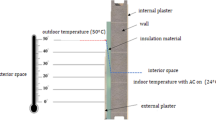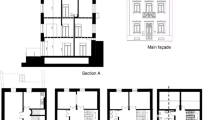Abstract
New effective technologies and materials that have the potential to reduce energy demand with excellent energy efficiency and low environmental impact are urgently required in the Gulf Region. Dynamic insulation, which functions by recycling fabric heat loss back to the building, has been established theoretically and proven in pilot projects. It sets the green, low carbon benchmark for thermal insulation in buildings. This paper presents details of the Eco-Villa, its construction, how the performance of the villa was monitored, and the findings from the initial monitoring phase and the dynamic simulation model (DSM). The villa was tested in two modes, bypass (static) and dynamic. The static U value of the external envelop wall was estimated at 0.24 W/(m2·K) in bypass mode. The theoretical dynamic U value changed from 0.24 to 0.05 W/(m2·K) when the ventilation airflow was varied from 0 to 0.001 m3/(s·m2) (0 to 1 L/(s·m2)), with a further small reduction occurring when the flow rate increased beyond 0.001 m3/(s·m2) (1 L/(s·m2)). The design ventilation rate for the Eco-Villa was 0.0008 m3/(s·m2) (0.8 L/(s·m2)), which yielded a theoretical dynamic U value of 0.063 W/(m2·K) compared to a measured U value of 0.125 W/(m2·K). The reduction in the fabric conduction gain was found to be 41% whereas the estimate from the DSM was 38%. The results demonstrate the fabric energy efficiency improvements that can be achieved through the use of dynamic insulation.
Similar content being viewed by others
References
Anon (1984). Dynamic insulation: the next step? Australian Refrigeration, Air Conditioning and Heating, November: 47.
Arquis E, Langlais C (1986). What scope for dynamic insulation? Batiment International Building Research and Practice, 19: 84–93.
Bailly NR (1987). Dynamic insulation systems and energy conservation in buildings. ASHRAE Transactions, 93(1): 447–468.
Brown AR, Imbabi MS, Peacock AD (2008). The transforming technology of dynamic breathing building. Paper presented at Ecocity World Summit 2008, San Francisco, USA.
Claridge DE (1991). The measured energy impact of air leakage on frame wall systems. Final Report, DOE, USA.
Dalehaug A (1993). Dynamic insulation in walls. Research Report No 53. Hokkaido Prefectural Cold Region Housing and Urban Research Institute, Japan.
Dimoudi A, Androutsopoulos A, Lykoudis S (2004). Experimental work on a linked dynamic and ventilated wall component. Energy and Buildings, 36: 443–453.
Elsarrag E, Aboulnaga M, Peacock A, Imbabi MS (2006). Dynamic insulation for energy conservation and improved indoor air quality in hot humid climates. Paper presented at ASHRAE 5th Chapter Regional Conference (CRC), Dubai, UAE.
Elsarrag E, Imbabi MS (2009). Evaluation of dynamic insulation for zone ventilation and air conditioning in the gulf region. Paper presented at ASHRAE Symposium on Sustainability and Green Buildings, Kuwait.
Taylor BJ, Imbabi MS (2000). Environmental design using dynamic insulation. ASHRAE Transactions, 106(1): 15–28.
Taylor BJ, Cawthorne DA, Imbabi MS (1996). Analytical investigation of the steady-state behavior of dynamic and diffusive building envelopes. Building and Environment, 31: 519–525.
Taylor BJ, Imbabi MS (1997). The effect of air film thermal resistance on the behaviour of dynamic insulation. Building and Environment, 32: 397–404.
Taylor BJ, Webster R, Imbabi MS (1998). The building envelope as an air filter. Building and Environment, 34: 353–361.
Author information
Authors and Affiliations
Corresponding author
Rights and permissions
About this article
Cite this article
Elsarrag, E., Al-Horr, Y. & Imbabi, M.SE. Improving building fabric energy efficiency in hot-humid climates using dynamic insulation. Build. Simul. 5, 127–134 (2012). https://doi.org/10.1007/s12273-012-0067-6
Received:
Revised:
Accepted:
Published:
Issue Date:
DOI: https://doi.org/10.1007/s12273-012-0067-6




